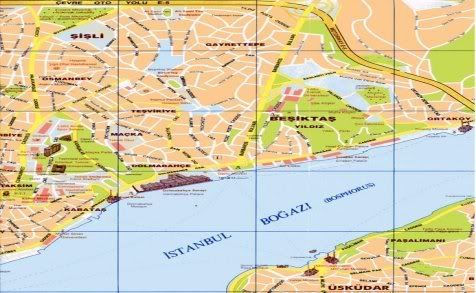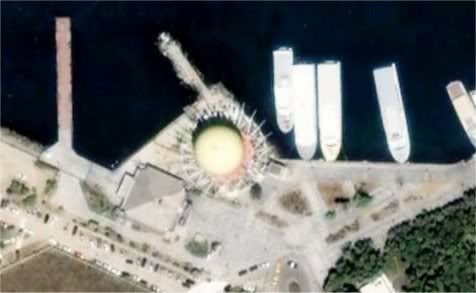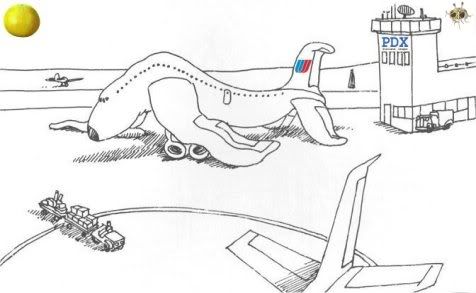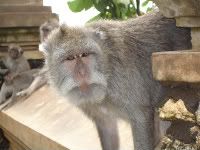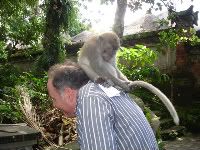Talking Türkiye
#31
Original Poster
Join Date: Feb 2000
Location: Lake Oswego, OR
Programs: UA 1K 2MM, Marriott Lifetime Platinum, Hilton Diamond
Posts: 3,202
The Giant Grapefruit
Great report and great pictures!
As it happens, I took precisely the same journey earlier this year, snapping almost exactly the same picture, and I can reveal to you the anticlimactic secret behind the energy weapon: it's the Türk Balon, or a sightseeing balloon that's supposed to hoist itself and its sightseers 200 meters up into the air. Alas, I gather that it hasn't been up and running for quite some time now...
As it happens, I took precisely the same journey earlier this year, snapping almost exactly the same picture, and I can reveal to you the anticlimactic secret behind the energy weapon: it's the Türk Balon, or a sightseeing balloon that's supposed to hoist itself and its sightseers 200 meters up into the air. Alas, I gather that it hasn't been up and running for quite some time now...


However, I had a little extra time before my return flight to FRA so I fulfilled the promise I made to myself and hopped on a boat to Kadiköy. Once there, I learned of a great conspiracy and discovered the true reality of the giant grapefruit.

All will be revealed (with photos, of course), in the concluding chapter.

#32
Join Date: Oct 1999
Location: St. Louis, MO
Posts: 2,055
...However, our conversation was rudely interrupted by the liberal spray of lemon juice drops and the strident sales pitch of Crazy Achmed, who stood proudly in the middle of the deck and loudly harangued a surprisingly appreciative audience about the wonders of his incredible lemon juicing device.
I am intruigued by Crazy Achmed's portable lemon juice machine. It seems amazing. Did you purchase any extras by chance?
#33
Original Poster
Join Date: Feb 2000
Location: Lake Oswego, OR
Programs: UA 1K 2MM, Marriott Lifetime Platinum, Hilton Diamond
Posts: 3,202
The Pirates of the Barbarossa Coast
The Sick Man of Europe
We have a sick man on our hands, a man gravely ill, it will be a great misfortune if one of these days he slips through our hands, especially before the necessary arrangements are made.
-- Tsar Nicholas I of Russia, referring to the decaying state of the Ottoman empire, as translated by Harold Temperley in his book, "England and the Near East."
The bear dies the bear is dying you may give him musk but even musk will not long keep him alive.
-- An alternative translation.
-- Tsar Nicholas I of Russia, referring to the decaying state of the Ottoman empire, as translated by Harold Temperley in his book, "England and the Near East."
The bear dies the bear is dying you may give him musk but even musk will not long keep him alive.
-- An alternative translation.
For a sultan who put so much effort into staying in touch with his people, it may come as somewhat of a surprise to learn that he also built one of the most extravagant Ottoman palaces the empire had ever seen. This, in a civilization not exactly known for understatement. The palace was built in the middle of the 19th century for a cost that was equivalent to 35 tons of gold so I suppose the word "extravagant" could be considered a matter of interpretation.
When Abdül Mecid I was growing up, he had fond memories of his princehood days scampering around the gardens of a large wooden compound called "Beşiktaş Waterfront Palace" that had been built on the edge of the Bosphorus so that the sultanic family could escape the summer heat and tedium of life at the family hovel at Topkapi Palace. And during his carousing years, I'm sure he cavorted with quite a few attractive BeŞiksas at the Beşiktaş palace.

When he finally achieved sultanhood, Abdül Mecid I ordered the summer shack torn down and replaced with a huge and sumptuous stone palace. The new family abode contained 285 rooms and boasted a waterfront façade over a quarter of a mile long. He stocked his palace with the largest collection of Bohemian and Baccarat crystal chandeliers in the world and even featured a staircase banister made of crystal.
The Stuffed Garden
The site of the palace was on a bay by the shores of the Bosphorus that had been gradually filled in over time to become a luxurious garden that long had been a highly favored spot for Ottoman sultans and princes to hang out. In fact, the word "dolma" actually means "stuffed," as is evidenced by the countless varieties of dolmas, vegetables stuffed with meat or rice, that are common components of cuisine in that part of the world. Also, thousands of dolmuşes careen through Turkish streets, and these are basically minivans stuffed with people.
The Turkish word, "bahçe" means "garden" so when the elaborate palace was finally constructed on the site of the original stuffed garden, it was only natural that it would be called Dolmabahçe. And I would imagine that the sultan and his retinue probably picnicked on dolmas during the formative days of "Beşiktaş Waterfront Palace."
That money was no object is easy enough for a sultan and the fact that he did not have enough money to fulfill his grandiose vision didn't stop him either. The Ottoman empire had been regarded as "the sick man of Europe" for quite some time, so I guess it was much easier to create prosperity as an illusion rather than reality.
I had walked along the perimeter of the outer walls Dolmabahçe palace during my evening stroll when I first arrived in Istanbul so today I thought that it might be a nice idea to meander into the elaborate compound and poke around a bit. It is actually located a very short walk from the terminus of the Taksim to Kabataş funicular. However, instead of walking over to Taksim and hopping on the funicular, I figured that it might be a pleasant change of pace to walk directly to the palace from the Hilton.
Given the nuances of Istanbul topography, that means what appeared to be a very short walk as the karga flies, took me nearly an hour through winding and hilly streets, many pockmarked with craters and dangerous construction zones. I walked out of the Hilton lobby and over to the busy Cumhuriyet Caddesi, a street apparently lined with dozens of travel agencies. I continued past a busy intersection that displayed a circular red and white sign that seemed to admonish me not to toot my own horn. I then walked down a side street in which a horse drawn carriage zipped along heavily laden with a fresh load of mosque melons.

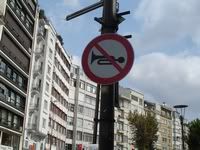
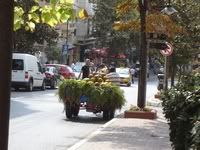
To the right, I strolled past the Istanbul Military Museum, which, somewhat counterintuitively, first opened inside Hagia Irene church, near Topkapi Palace. The museum advertised some exhibits of mild interest, such as the chain that had been used by the Byzantines to block ships from entering the Golden Horn but I was not much in the mood to study yet more examples of violence and aggression.
I continued past the museum and turned around the corner, which placed me on Eytam Caddesi and then veered to the left though a very busy intersection onto Kadirgalar Caddesi at which point the road split. To my left, was the greenery of Maçka Park and overhead I noticed a small cable car had cheated the depths of the valley by transporting passengers between Taksim and Macka. Further down the road, I walked by an amusement park whose colorful lights had illuminated the sky during my quiet evenings at the Hilton.
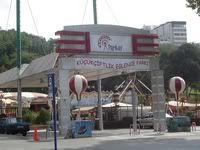
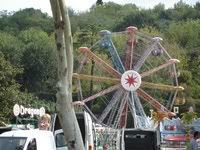
A few minutes later, the sidewalk vanished entirely and the heavily trafficked roadway was narrowed further by two competing construction zones lining both sides of the road. I turned around briefly amidst the auditory assault to see the Hilton looming over me, perched quietly atop a nearby hillside. I could have completed my 50 minute circuitous trek in a mere five or ten minutes had the pathway been straighter, flatter and not littered with so many boulders and craters.
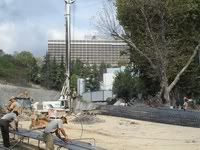
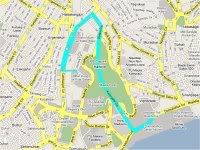
At the bottom of the hill, I was able to avail myself of a traffic signal to wade through the fast flowing river of vehicles amassed in the vicinity of the baroque-style Dolmabahçe Mosque. Construction of this mosque was initiated by Sultan Abdül Mecid's mother when work on the palace was finished and her son wrapped it up it up a couple of years later, after she died. From the mosque, I walked into the park-like grounds that led towards the Treasury Gate entrance of the palace. To my right, stood the four-story Dolmabahçe clock tower, built about 50 years after completion of the palace.
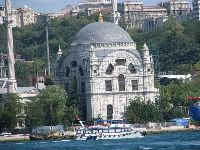
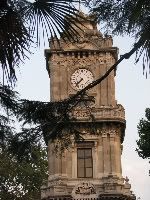
As I sought the terminus of the lengthy ticket queue, I initially concluded that I had made a wrong turn, or, at the very least, the Oregon Trail had extended a lot further than I had thought.
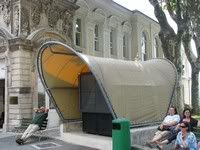
While I waited to pay my entrance fee, numerous tourists crowded around to witness the changing of the guard. Based on my lengthy tenure within the compound over the next few hours, it seemed like this very unique and important event happened every five minutes or so. Once the parade had concluded, one guard remained behind, where he stood completely motionless, with one hand clutching a very large knife as visitors stood before him and tried to attract his attention.

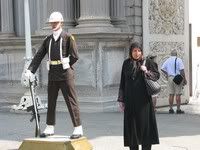
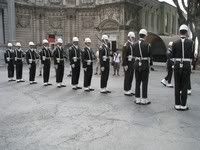

The Golden Fleece Award
When it was finally my turn to purchase a ticket, I learned that I would need to pay two hefty fees, one for entrance to the main part of the palace and one for entrance to the harem. They also required a fee for photography and an additional fee for video. Already feeling sufficiently fleeced, I did not bother visiting the "clock museum," which would have also required a separate fee.
While doling out the Turkish lira, I thought back briefly to the ancient mythology of the area. According to legend, the Argonauts once anchored in this quiet cove along the Bosphorus in their quest for the golden fleece. I guess that the Turkish Ministry of Tourism, the entity that operates the palace, really did manage to locate the golden fleece at this very locale.
 I also learned that one can rent the Ceremonial Hall and gardens for private receptions such as weddings but I am not sure whether or not such bookings typically include the photography fee in their rate.
I also learned that one can rent the Ceremonial Hall and gardens for private receptions such as weddings but I am not sure whether or not such bookings typically include the photography fee in their rate.After dutifully stowing my backpack in a locker, I underwent a metal detector and security screening, after which I was finally permitted to pass through the Hazine Kapisi, or "Treasury Gate," which is what most of the commoners would have used during Ottoman times. The gate that the sultan would have used was called, surprisingly enough, the Sultan Gate and currently faces the very busy Dolmabahçe Caddesi so it is rarely opened these days.
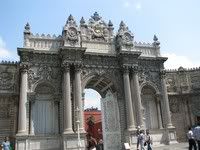
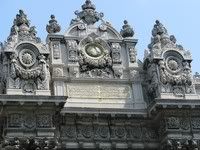

Inside the palace compound was the Imperial Garden, very well manicured, with an abundance of carefully tended plantings, flowers and even a few of the sultan's pets. In the middle of the garden was a large circular pool that contained an ornamental swan fountain.
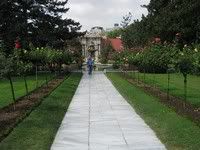
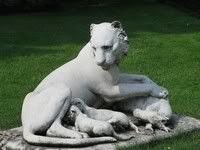

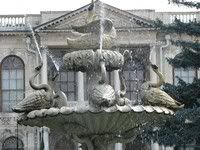
Shake Your Booty
A short distance past the swan fountain stood a very important building, the Selamlik, the domain of the men, which was used as administrative apartments. In general, rooms facing the Bosphorus were used by various higher level officials and state ministers, whereas rooms with a "garden view" were used by an assortment of palace administrators and state officials. I am not sure how they handed upgrades for frequent guests.
 I immediately recognized that this was a very important structure because snaking up its wide stone steps was a very long line of people waiting to enter the building.
I immediately recognized that this was a very important structure because snaking up its wide stone steps was a very long line of people waiting to enter the building.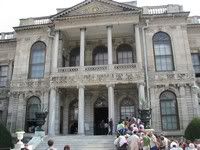
Twenty five minutes elapsed before I finally mounted the top of the steps, where I noticed that many of the visitors were covering their feet with small purple garbage bags. I figured that if this is the custom, who am I to argue so I dug into the gaping maw of a big plastic garbage can and grabbed a handful of the little booties. I think they were only available in a size 4 so I managed to break about six of them until I finally convinced a couple of the booties to stick. Nearby, I noticed a couple of refuse containers that had been labeled "cop rubbish" so I assumed that they were strictly limited to use by the security staff.

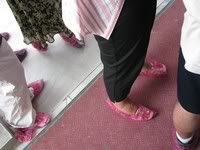
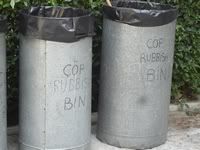
Inside the Medhal Salon, the entrance hall, I was advised that a guide is required at all times and tours leave every 20 minutes, alternating successively between English and Turkish. As the tour began, we were sternly warned not to stray off of the red carpet and to make sure to keep our booties on at all times. From the entrance hall, we eventually entered a room containing an ornate crystal staircase. The banisters of the double horseshoe-shaped staircase were comprised of Baccarat crystal, the ceiling was made of crystal and, in the center of it all, was a 1.5 ton crystal chandelier, perhaps one of the smaller ones in the palace.

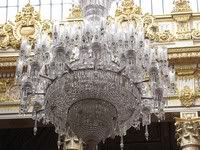
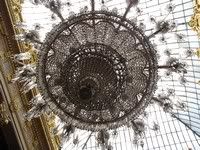
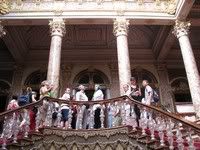
Much of what was not assembled of crystal, marble or mahogany was made of gold. Indeed, at least 14 tons of the material had been used to guild the ceilings and embellish the walls and doorways.


After ascending the crystal staircase, we entered the Süfera Salon, a waiting area where ambassadors would have been entertained while awaiting an audience with the sultan. This room contained a variety of unique and unusual chachkas, including a number of huge bear rugs and some very small elephants.

The tour guide really had very little to say as he herded us around from one room to another, all of us obediently trundling along in our cute little purple booties. I think his primary function was mostly to keep all of us out of mischief and to make sure nobody wandered off of the red carpet. He did not do a very good job in my case, however, because I accidentally lost track of my group and inadvertently became affiliated with a different troupe of visitors entirely.
My new guide was much more informative than the first one and had numerous stories to share, all of which I thoroughly enjoyed except for the fact that the verbiage was entirely in Turkish.
 Nevertheless, I think I learned more from my new tour leader even though I understood not a word of what she was saying.
Nevertheless, I think I learned more from my new tour leader even though I understood not a word of what she was saying.We eventually wandered into the Zulvecheyn Salon, an entrance hall that leads to apartments used by the sultan when he was not cavorting in the harem. Visitors were received by the sultan in the "red room," which provided beautiful and expansive views of the Bosphorus. From there, we returned to the vicinity of the crystal staircase and continued on to everyone's favorite part of the palace, the sultan's bathroom, which was actually comprised of three separate rooms. What luxury! ^
From the sultan's bathroom, we entered a long nondescript hallway which was actually a passageway connecting the Selamlik section of the palace with the harem. When the sultan was in residence, this corridor was strictly guarded and only the sultan and his eunuch servants were able to traverse it. Women would sometimes gather in the hallway to peer through two small semi-circle windows in order to view any shindigs in progress in the cavernous Ceremonial Hall, which were strictly stag affairs.
This ugly corridor was actually one of my favorite sections of the palace because one of its semicircular blue and white windows was partially open, letting in a tiny trickle of fresh air waft in off the Bosphorus. Some of my Turkish tour mates giggled as I spread my arms in front of the window and emitted a great sigh of relief as I enjoyed the very brief exposure to the cooler Bosphorus breezes, evidently the palace's sole source of air conditioning.
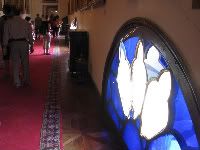

I was eventually led away from my window with great reluctance and was then obliged to continue on the tour where I inspected an assemblage of rooms and suites in which various wives, the sultan's mother plus a gaggle of other relatives would have resided. I also poked my head into an assortment of guest rooms but the style was not quite my taste and I much preferred my current residence at the Hilton. That being said, I still cannot fathom why the Hilton considers that melding together two single beds constitutes a king size bed.


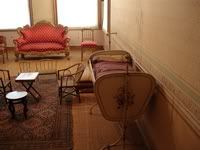
In later years, after the collapse of the Ottoman empire, the founder of the Turkish republic, Kemal Atatürk, lived in this section of Dolmabahçe Palace whenever he was in town. While touring his private residences, I also wandered past Atatürk's toilet, which was clean and spotless, with nary an Atatürd to be found.

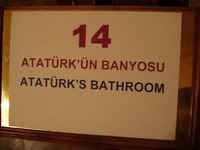
We then wandered into Atatürk's bedroom, in which stood a bed covered with a vivid red bedspread adorned with a huge Turkish icon. I guess that if he woke up groggy one morning after a late night bender, it probably helped him remember what country he was in.
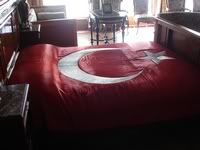
In the time of the sultans, it was probably considered a terrible faux pas to think you were ruler of another country, not that a long succession of Ottoman rulers hadn't tried exactly that numerous times in the past. I cannot help but wonder whether the violent Ottoman civilization would have taken an entirely different course if only they had deployed a nice Ottoman bedspread similar to this one.
In any case, during a visit to Istanbul on November 10, 1938, Atatürk ultimately died in this very bed. As a symbolic gesture, all clocks in the palace have been stopped at 9:05 AM, the exact moment of his death but at least they still show the correct time twice a day. I am very proud that I learned all of this without visiting the clock museum.
Master of Ceremonies
From the harem, the Caliph's staircase led back to the entrance hall and into the Muayede Salonu, the Grand Ceremonial Hall. The sultan used this staircase at the conclusion of religious ceremonies in the Ceremonial Hall or to visit his family in the harem.
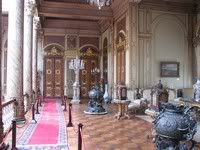
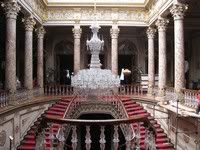

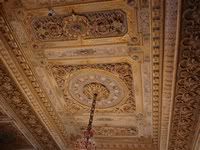
The vast and expansive ceremonial hall spanned an area of 2000 square meters, reaching a height of 36 meters and was supported by 56 columns. At its center hung a 4.5 ton Irish crystal chandelier equipped with 750 lights, to this day, it is the heaviest chandelier in the world. I understand that it took several weeks to clean but the sultan's staff were up to this type of task.


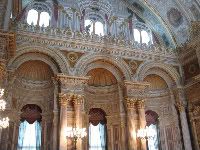
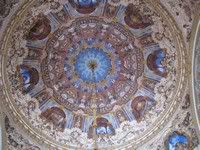
The chandelier was actually given to the sultan as a gift by Queen Victoria, who probably realized that he could not afford to buy such a chandelier on his own with a meager sultan's income. This was certainly a very nice gesture on her part, especially since it required that she take off some time from her true passion of racing.


The upper perimeter of the great hall included a series of balconies in which observers could view the spectacular ceremonies unfolding below them. The "Observers Alcove" was set aside for high muckamucks, the "Ambassador's Alcove," was devoted, not surprisingly, to ambassadors and a third alcove was allocated to the orchestra. Finally, women were allowed to peer in from their hallway through the small semi-circular windows.
The ceremonial hall, which could accommodate 2500 men during its special events and religious ceremonies, would be heated by hot air blown out from the base of the 56 columns. Evidently, the copious amounts of hot air emitted by visiting dignitaries and resident politicos was not quite up to the task. On especially cold winter days, it might take as many as three days for the great hall to be made toasty enough for the sultan and his fellow party goers. On particularly important occasions, the sultan's golden throne would be carried over from Topkapi Palace where he would sit and hold court.
From the ceremonial hall, I was obliged to march through a gift shop gauntlet before I was finally able to make my escape to the edge of the Bosphorus, where I stood for a while watching ferries crisscross their way between Europe and Asia. In front of me, several "watergates" had been built into the ornate outer railing, where dignitaries would arrive by barge and the sultan could board his private ships. To my right, an object that looked like a tall festivus pole, had been positioned near one of the watergates. From there, I continued walking towards the northern end of the compound and then turned to the left, where I sought out the entrance to the harem.
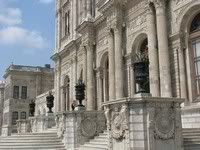
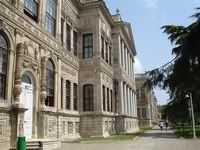
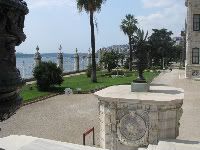
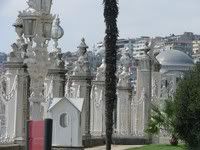
On my 10 minute walk over to the official point of entry for the harem tour, no less than two additional processions of guards marched on past, no doubt on the way to fulfill their many important and serious duties, such as verifying whether all visitors were wearing booties.
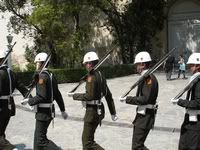
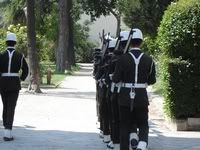
Please Don't Argue!
The entrance to the harem was demarked by a moderately sized line of people standing behind a multilingual sign that listed the embarkation times for the next English and "Turkçe" tours. It also carefully delineated several essential rules of conduct, the most important of which was, "Don't argue about the tour time."
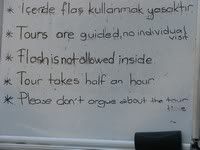
Once the start of the tour was announced, we endured yet another security screening and a booty check. Given that my current frazzled pair of booties had been subjected to the full assault of dirt, grime and exposure to the outside elements on the long walk over to the harem, one would have thought that a changing of the booty would have been in order but that was not the case.
Unlike Topkapi Palace, the harem at Dolmabahçe was not a separate structure but was merely consigned as a segregated wing encompassed within the overall building. Given that the sultan had more than a few women in his service, I guess it should not be surprising that the harem actually constituted over two thirds of the allotted floor space of the palace.
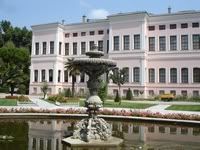
Besides the passageway used by the sultan and his eunuchs to access the harem from the Selamlik section of the palace, the official harem entry hall could also be accessed from the garden and the street. However, all visitors to the harem needed to pass through a rigid screening system that was even more harsh and severe than the one that I had endured a little earlier. Women would be delivered by carriage to the threshold of the harem, whereupon they would be escorted through the door of the most feared resident of the palace and endure the harsh gaze of the sultan's mother.

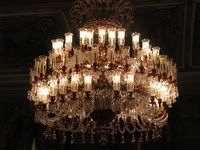
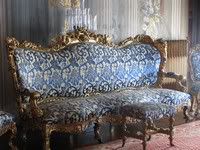
The Mother of All Harems
The sultan's mother monitored the comings and goings of every other woman in the palace and ruled over a very strict hierarchy, including the mistress of the harem and all of the concubines. The mistress ruled over a first class tier of maids in waiting, including the head housekeeper, head food taster, head urn carrier, the head coffee maker, head of the laundry and the head barber. That shows you how much I know -- I would have thought that all barbers would be "head" barbers.

Serving the supervisory level of harem women would be a second tier of servants who, in turn, had their own staff and assistants. There were third and fourth level tiers as well, extending on down to the nursing and medical staff.
Rank was the sole determinant of the size and quality of rooms in the harem, with the sultan's mother occupying the largest and most opulent space. The first class tier would occupy the next largest rooms, followed, in turn, by the lower level servants, the staff of eunuchs and the chambermaids. I am not at all clear how frequent guests would have fit into the grand scheme of things.
Each set of apartments was assigned its own suite of servants and a full complement of concubines served the needs of the sultan, his mother and his children. The chief governess supervised the wet nurses who attended to the needs of the little princes and princesses. The daughters of the wet nurses also attended to the needs to the children, who would often have as many as 10 women looking after them. But it was the sultan's mom who ruled over the entire operation.
Branching off from the sultan's mother's apartment were other apartments, rooms and meeting halls. The "hall of the royal consorts" was often used to host festivities honoring family gatherings and the passage of special life events of the children and the family, such as learning how to read. The pink salon was essentially used by the sultan's mother as a living room in which she also hosted family gatherings that would be attended by special guests, other high level residents of the harem and sometimes even the sultan.

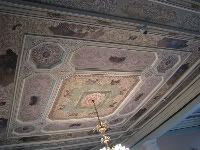

My group was escorted through the harem for about 45 minutes but we were mostly left to our own devices during that time. As had been the case during the earlier tour of the Selamlik and the Muayede Salonu sections, very little value had been added by the guide. After I finished viewing what I came to see, I wandered back outside, walking past some elaborate sculptures and a eutrophic pond inhabited by the royal geese. As is evidenced by a trash container overflowing with empty water bottles, the harem tours were very thirsty work.

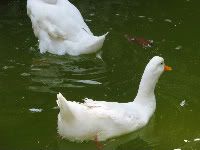

As I started on my way out of the palace grounds, I concluded that, while certainly ornate and elaborate, the assortment of halls and residences often appeared to be nothing more than an overstated symbol of form over function. Even the Selamlik, the officially designated "men's section" of the palace, was furnished in a Victorian style and fashion more suited to refined elderly ladies drinking tea while chatting about the weather. This is especially ironic given that women, elderly or not, would never be able to even glimpse the interior of the men's residence under any circumstances.
From its inception, the entire complex had been conceived as a symbol and showpiece, an Ottoman interpretation of western-style decadence that was intended to project an image of how they wished to be perceived rather than who they actually were. I also realized that the exhibits within the palace really served a dual role, even if that had not been their intent.
Stuffed within Dolmabahçe was a sincere and heartfelt homage to the Kemal Atatürk, the founder of the modern Turkish republic. But he was not the only important historical figure to die within the palace walls. The palace was also a monumental epitaph to the demise of the Ottoman lineage, the final palace of the sultan dynasty before the Ottoman empire finally let out its last breath and vanished into history.
On my way out of the complex, I walked by the locked Gate of the Sultan, which, as the name suggests, is what the sultan would have used for his comings and goings. In the early days of the palace, an extensive network of supporting buildings such as stables, kitchens, servants quarters and a flour mill stretched for a kilometer or so in all directions. The complex even extended far up into the hillside that overlooks the palace but much of that has been gobbled up by road expansion and the somewhat controversial construction of a Swiss hotel on the hillside.
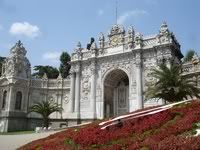
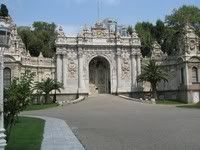
From Cradle to Grave
It's great to be a pirate
And live a life of pleasure
We fight with swords and swing from ropes
And hunt for buried treasure.
We make our prisoners walk the plank
Sharks love us when we feed `em.
We wear those patches on our eyes
When we don't even need `em.
-- It's Great to Be a Pirate
And live a life of pleasure
We fight with swords and swing from ropes
And hunt for buried treasure.
We make our prisoners walk the plank
Sharks love us when we feed `em.
We wear those patches on our eyes
When we don't even need `em.
-- It's Great to Be a Pirate
Hayreddin Barbarossa was one of four brothers born to a Turkish father on the Greek island of Lesbos. Originally named Hizir, he and his brothers were all accomplished traders and seamen but their original careers soon began to run afoul of aggression by the Christian privateers, the Knights Hospitaller. One of the brothers was killed during an attack on a trading mission and, figuring that if you can't beat them, join them, the surviving brothers launched their own career as privateers, possibly becoming the most successful and feared pirates ever seen in that part of the world.
Over many years, Hizir's brother, Oruç undertook a series of very successful naval conquests during which scores of ships and a huge amount of territory were captured throughout the Mediterranean and eventually well into northern Africa. Spanish Muslims began to refer to him as "Baba Oruç" but the name eventually evolved into "Barbarossa," which means "redbeard" in Italian.
Oruç eventually anointed himself Sultan of Algiers but as their naval activities came under continued Spanish scrutiny and frustration, the brothers officially joined the Ottoman empire, Spain's main rival. In 1518, Oruç and another brother were killed in a major military battle with the Spanish in Algiers. The sole surviving brother, Hizir, inherited his brothers military toys, his mission and his name,"Barbarossa." Sultan Selim The Grim also bestowed on him the title Beylerbey, which means, "Commander of Commanders."
Barbarossa filled this role admirably for the next 28 years, capturing or sinking scores of ships, sacking cities, attacking forts, and raiding numerous ports and castles along the coastline. As a result of his legion of successes, the pirate was eventually appointed fleet admiral of the Ottoman navy and chief governor of North Africa.
Suleiman the Magnificent nicknamed Barbarossa "Hayreddin," which means "Goodness of the Religion" and granted him the honorific Pasha, "Great Admiral." In 1538, Pope Paul III organized a "Holy League" to combat Barbarossa and the Ottomans but Barbarossa easily defeated the entire fleet.
An undefeated Barbarossa eventually retired from piratehood to take up a quiet life in Istanbul, where he wrote his memoirs. He died a year later and his remains are entombed in a mausoleum near Beşiktaş, right at the site of the harbor where he used to assemble his fleet.
After being reunited with my backpack, I exited Dolmabahçe from the Treasury Gate and then turned around the corner onto Dolmabahçe Caddesi to begin my walk towards Beşiktaş. I had briefly visited this district on the evening of my arrival in Istanbul, where I had walked past the ferry port and onto the quay, watching lucky anglers land their catch and even luckier cats pirate it from them.
I eventually came upon a very busy traffic interchange, where Dolmabahçe Caddessi morphed into Beşiktaş Caddesi. To my left, an even busier avenue joined the fray, Barbaros Bulvari, named after the pirate Barbarossa. As I waited for a traffic signal to turn in my favor, I gradually perceived that people were looking at me oddly, even more so than usual.
 It took me a few more moments to realize that I had neglected to take off my purple booties when I had exited Dolmabahçe!
It took me a few more moments to realize that I had neglected to take off my purple booties when I had exited Dolmabahçe! 
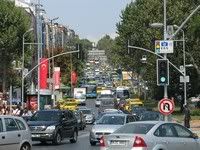
I safely removed my Dolmabahçe booties under the bemused glances of passersby and briefly wondered whether the fine folks at Dolmabahçe Palace would send off a detachment of their guard to reclaim them, at least when the guard was not otherwise busy changing. But nobody came after me so once I had stripped them off of my feet, I quickly threw them into a nearby pile of garbage from whence they had come. The only thing that had been damaged from the experience was my pride.
Directly across the street from me stood the Beşiktaş Mosque, whose construction was initiated by the original Barbarossa in 1555 and later completed by his brother. For many years afterwards, a tradition arose in which members of the Ottoman Armada would pray at the foot of Barbarossa's tomb before commencing on their naval adventures.
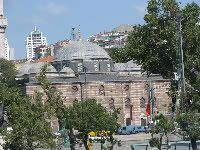
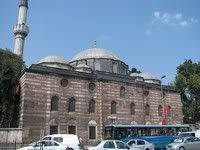
From Barbaros Bulvari, I turned east towards the Bosphorus, passing by a small otogar where a collection of red, green and blue buses had been deployed to unload their cargo of passengers. Beyond that, two boats from Asia were pulling into the ferry port and the nearby shore of the Bosphorus was lined with its usual thick installation of anglers and more than a few cats. Right next to the ferry terminal, the naval museum was housed in a three story building that included a ground floor devoted to Atatürk and several other floors that encompassed a varied collection of naval artifacts and memorabilia.
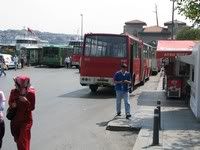
Amongst its artifacts, the museum contains a copy of Barbarossa's war flag, which bears symbols of Judaism, Christianity and Islam. The inscription at the top of the flag is derived from the Fatih chapter of the The Qur'an and reads, "Mohammed! Reveal good news to the believers that the conquest is soon."
Below the inscription are crescents containing the names of the first four Islamic Caliphs and in the middle of the flag is the Christian symbol of the Trinity. Towards the bottom of the flag is the Star of David, which is not only an icon of Judaism but is also a good luck charm in certain Middle eastern teachings and is a symbol for masculine-feminine in the Far-East. With respect to the Jewish symbolism, Barbarossa and the Ottoman Navy had been trading quite a bit with Jewish traders during their conquest of the Mediterranean and the use of this symbol emphasized the Ottoman reign and protection of the Jewish population.
Across from the museum and the ferry docks, a monument dedicated to the pirate Hayreddin Barbarossa had been erected in a central square, which was also the current resting place of his mausoleum.


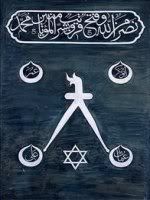
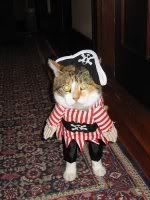

From the center of Beşiktaş, I continued walking further northeast along Beşiktaş Caddesi until the road became Çiragan Caddesi, near the Çiragan Palace Kempinski Hotel. I had first glimpsed this hotel during my cruise to Anadolu Kavaği and recalled that it had been reconstructed from the ashes of the semi-stillborn Çiragan Palace, built 10 years after the construction of its neighbor, Dolmabahçe Palace.
The original Çiragan Palace had been built at a time when the Ottoman empire was in such a state of decline that the other countries of Europe were in heated debate amongst themselves about how they could best exploit the situation and scavenge the remains. A rapid succession of sultans lived at Çiragan for a short time and died very quickly. Since its opening in 1990, the tenure of the Kempinski Hotel version of the palace will soon surpass that of its original incarnation.
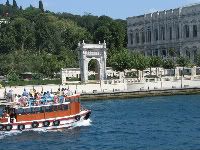
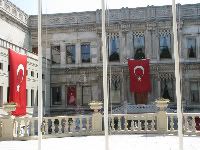
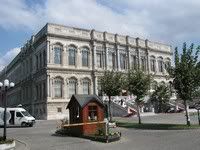
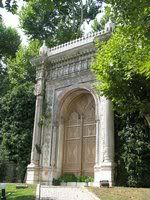
The Village in the Middle
From the Çiragan Palace, I continued further up the avenue until I arrived in the vicinity of the suburb of Ortaköy. Literally translated as "the village in the middle," Ortaköy has played host to a diverse assemblage of cultures and religions from the time of the Byzantines, including Jews, Muslims and Christians. The Turkish people, as such, had no significant presence there until the 16th century, when Sultan Suleiman I first encouraged Turks to settle there.
Today, Ortaköy still symbolizes a heterogeneous assemblage of people and culture at many different levels. Jewish, Christian and Muslim religious institutions are practically neighbors. The community's location nestled at the base of at the western pylon of the Bosphorus Bridge symbolizes its role as a crossroads between European and Asian cultural influence. People of all ages have lived there for centuries but its dense concentration of cool boutiques, chic cafes, artsy galleries and hyperactive nightclubs also attract hordes of young sophisticates, both long time residents and first time visitors. Even its architecture is an amalgamation of old and new.
My first destination at Ortaköy was one of its most important and eminent architectural icons, the Büyük Mecidiye Camii, the Grand Imperial Mosque of Sultan Abdül Mecid. The sultan ordered this mosque built to replace an earlier structure at around the same time as his other great work, the Dolmabahçe Palace.
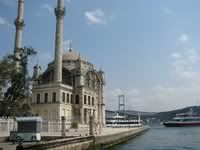

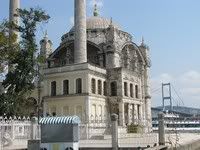

The position and orientation of the mosque at the very tip of the Ortaköy pier almost makes it seem to float on the water if viewed from certain angles and lighting conditions. Its neo-baroque style when juxtaposed against the backdrop of the modern superstructure of the Bosphorus Bridge further augments the overall schizophrenic nature of the Ortaköy suburb.

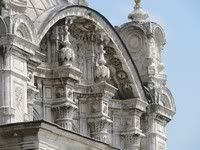
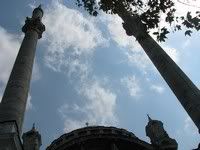
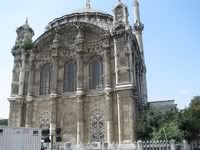
From the Ortaköy Mosque, I walked along the pier for several minutes and then settled down to rest for a while in the middle of the Iskele Meydani, the main square. I sat by the water for a few moments enjoying the sites, sounds and cooler Bosphorus breezes but not so much the smells. Copious amounts of cigarette smoke drifting in from all sides eventually drove me away so I opted to continue on my journey to explore the remainder of the town.
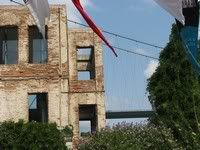
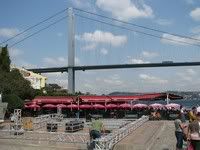
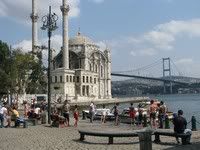
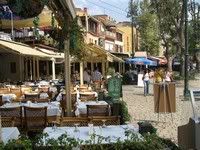
The Tree of Life
From the center of the main square, I walked back towards the main road, cutting through a small warren of narrow streets populated by restaurants and small cafes. After I arrived at Muallim Naci Caddesi, I found myself at the threshold of the very small and understated Etz Ahayim Synagogue. Jews had begun to settle in Ortaköy in the early 17th century after a major fire had decimated large parts of the Grand Bazaar. The original synagogue in Ortaköy was constructed in 1660 but was itself destroyed by fire in 1941.
The name Etz Ahayim means "Tree of Life" and the original marble ark containing a copy of the Old Testament survived the fire and currently resides as a monument in the garden. An adjoining Beth Midrash, a study hall, also survived the fire and emerged from the ashes to subsume the role as the actual synagogue.
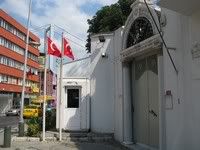
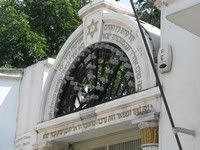
After concluding my exploration of Ortaköy, on the European side of the Bosphorus, I thought it might be nice to saunter over to Asia for a while. The Bosphorus Bridge looming over my shoulder would have been a very convenient, unusual and scenic way to accomplish this endeavor, but it was currently closed to pedestrians. A number of jumpers had been selecting it as an effective suicide venue so the authorities were obliged to close it to all pedestrians.
The only reasonable way to cross the Bosphorus would be by ferry and a ferry terminal was conveniently located just near the naval museum. However, after studying the posted schedule, I came to the conclusion that only a few boats a day visit Ortaköy, and these were all from Eminönü.
I had no choice but to exit town by schlepping all the way back to Beşiktaş. After walking along Çiragan Caddesi for a while, I was initially excited to see a reference to a ferry on a sign mounted on a nearby building. However, after trotting down some steps, I was frustrated to learn that the building was closed. Upon further inspection, I was even more disappointed to discover that the "Feriye Sinemasi" was not, in fact, a ferry terminal but was actually a movie theater.
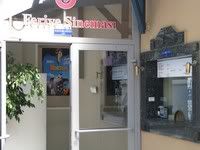
I eventually arrived back in the vicinity of Beşiktaş and marched past the homage to the pirate Barbarossa to find myself at the ferry port. In short order, a small ferry pulled in and I embarked upon the 20 minute ride to Üsküdar.
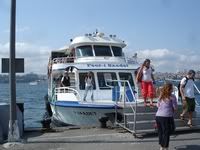
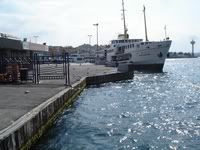
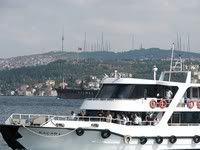
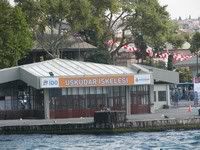
Journey to the City of Gold
The Greeks had named it Chrysopolis, the "city of gold," far back in the 7th century BC but there had never actually been any gold discovered there. Some people have postulated that the gold reference alludes to the amount of wealth that was concentrated in the little port or to the taxes and fees charged to those passing through. Others have hypothesized that it was an allusion to its golden sheen when viewed from across the Bosphorus strait at sunset.
Starting under Ottoman rule in medieval times, the city was called Scutari and kept this name until relatively recently. It was the terminus for caravan routes to Syria, Armenia and Iran and was a focal point for Asiatic couriers. Indeed, its modern appellation, Üsküdar, literally means, "courier." The city was the nucleus of trade throughout Anatolia up until the late 19th century, when the Haydarpaşa train station opened near Kadıköy and quickly subsumed this role. For a while, the area was inundated by a mass migration from more Islamic regions of Anatolia and it is still somewhat of a hub for some Islamic mystical sects. And if you don't want to schlep all the way to Turkey to visit Üsküdar, you can just rent the movie!
The town was well known as the location of the old Barracks Hospital, Florence Nightingales base during the Crimean War. Known for her founding role in the establishment of modern nursing, she instituted a number of new policies for the treatment of the sick and wounded, including the relatively new concepts of compassion and sanitary conditions. She also implemented a very strict rule that all of her "Nightingale nurses" wear uniforms and a scarf embroidered with the words "Scutari Hospital" so they would not be regarded as prostitutes when wandering outside the hospital. Much of this area has now been paved over and replaced by a shipping terminal and railway yard but the old hospital itself has been reincarnated as the Selimiye Barracks of the Turkish army.
After hopping off the ferry upon arrival at Üsküdar, I was confronted with a chaotic scene in which throngs of people squeezed past dense concentrations of immobilized traffic punctuated by several major construction zones. Work had recently begun on the Marmara Sea Tunnel, a commuter railway tunnel that will eventually provide for a seamless connection between Europe and Asia. However, given the history of the region, the pace of work has been significantly impeded by the continuous materialization of archaeological artifacts.
Isolated in the middle of Üsküdar Square was the Ahmed III Fountain, built by Sultan Ahmed III in the early 18th century and an important local source of water for residents in the area at the time. I noticed writing inscribed on its seaward side, which I interpreted to be either lines of poetry or a warning not to drink from it in order to forestall the possibility of "Mehmet's Revenge."

Throughout the duration of my walk, a steady parade of taxis, minivans and buses rumbled slowly in and out of the area. Residing on a corner across the extremely busy street was the Mihrimah Sultana Mosque, also sometimes referred to as the "Iskele Mosque" due to its proximity to the ferry terminal. It was built by Suleiman the Magnificent in honor of his favorite daughter, Mihrimah Sultana.
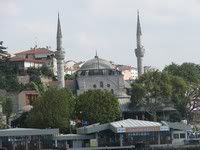
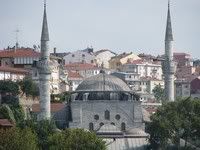
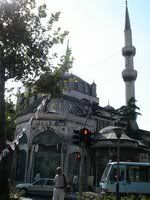
From Mihrimah Sultana Mosque, I proceeded down Selmanı Pak Caddesi, a very busy shopping street. A block away, I veered into a small covered bazaar, where an assortment of vendors vied for the attention of shoppers, hawking fresh fruits, vegetables, nuts, spices and fish.
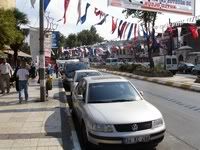
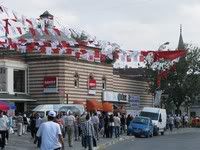
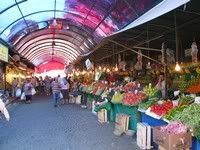
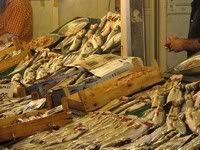
From there, I walked along for a few more blocks and then returned via the other side of street, taking me past Yeni Valide Camii, built by Suleiman the Magnificent for his mother. Thought to be somewhat of an odd bird, she had wanted to be buried in the open air so he built her a mausoleum in the shape of a bird cage, now somewhat overgrown by vegetation and a convenient home to neighborhood cats.
The cats are probably a bit frustrated because the meshed roof was designed to keep birds out while allowing rain to hydrate the garden. Adjacent to the mosque complex, old men sat around chatting, smoking and sipping tea. Some of them looked quite comfortable indeed and appeared to have been settled there for years.
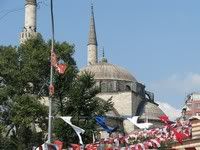
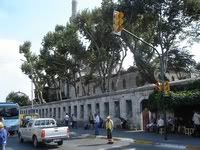
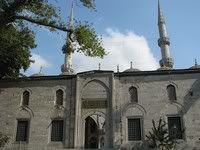

I soon found myself in a complex maze of narrow and winding streets, clogged by a never ending stream of vehicles. However, there did not seem to be much danger of a traffic mishap. During the 10 minutes or so that I spent walking through the area, I did not see the traffic progress even an inch.
Once back on the bustling and cacophonous main street, I began to wend my way back towards the ferry pier. Quite a few people were hanging around the area noisly yapping and a silver and blue truck was double parked on the side of the road bearing a sign labeled, "Yapi Kontrol." I briefly wondered whether the truck might be trying to do something about the noise.



I meandered through an obstacle course of traffic, barriers, fences and heavy equipment until I finally arrived back in the realm of Üsküdar Iskelesi, where I could then contemplate the best way for me to get back to the Hilton without yet another detour to Beşiktaş. I was delighted to discover that one of the ferries was scheduled to ply the waters directly back to Kabataş and was even more thrilled when the boat pulled in just minutes after my arrival.
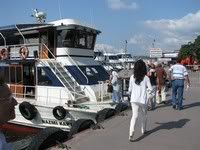
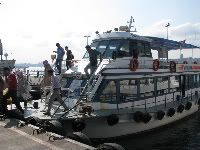
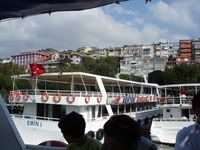
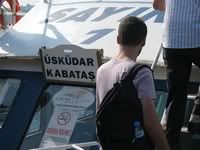
Talk Like a Pirate Day
During my boat ride back to Kabataş, I thought back to what I had learned about the litany of pirates and their sultanic pals during today's meanderings. I would bet that the area around Beşiktaş must be a real swinging place every September 19th if Cap'n Slappy, Ol' Chumbucket and the rest of his crew of scalawags were to descend upon the region in celebration of International Talk Like A Pirate Day. Perhaps I should devote a little extra time to brush up on the contents of the handy English-to-Pirate Translator and then return to the area some time in the future. On the other hand, Portland, Oregon is actually the birthplace of this important worldwide holiday so there are evidently plenty of timbers to shiver right at home.
In any case, whether I choose to celebrate the next International Talk Like A Pirate Day at home or in Istanbul, one basic fact can never be denied. As is very carefully explained in the very influential theological treatise, The Gospel of the Flying Spaghetti Monster, if only there were more pirates in the world, we would not need to contend with the serious global warming catastrophe that currently confronts us.
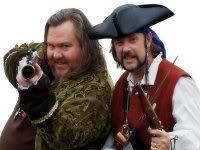

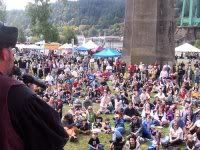
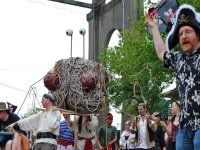
And so wrapped up my last full day in Istanbul as I continued my journey back to the poop deck at the Hilton. I would not be flying out until early in the evening of the next day, which afforded me just about enough time to plan a return visit to Kadiköy and get into some additional mischief.
Final Chapter: The Flight of the Giant Grapefruit
Last edited by LarryU; Nov 19, 2008 at 7:14 pm
#34
Original Poster
Join Date: Feb 2000
Location: Lake Oswego, OR
Programs: UA 1K 2MM, Marriott Lifetime Platinum, Hilton Diamond
Posts: 3,202
The Flight of the Giant Grapefruit
A.D.A.L.A.R.
During my earlier trip to explore the Princes' Islands, I had encountered a mysterious giant grapefruit perched on a small promontory of land near the district of Kadiköy, on the Anatolian side of Istanbul. At the time, I had vowed that I would get to the bottom of this puzzling and peculiar object but I now realized that I was running out of time. However, I was booked on a 5:50 PM flight back to FRA that evening, so perhaps that would give me just enough time to get to the bottom of this mystery once and for all.
My plans were helped, in no small part, by the discovery of some top secret spy satellite photographs that indicated a sudden flurry of activity in the vicinity of the giant grapefruit. After analyzing these photographs with a great degree of care and scrutiny that easily exceeded five minutes, I could come to no other conclusion than that the giant grapefruit was a major component of the Turkish space program.
But where would I be able to obtain more information about Turkey's top secret space program? Over the past week, I had furtively skulked around several different "Forbidden Zones" and had not become any the wiser for the experience. When I initially sighted the mysterious object, my ship had departed the Kabataş ferry docks and made its first stop at the port of Kadiköy. It had been a little difficult to spot at first but to the right of the sign displaying Kadiköy was another one that listed "ADALAR."
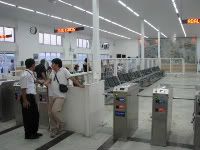
Everyone in Turkey claims that "Adalar" refers to the islands but it is actually an acronym for the Turkish space program, the Anatolian Department of Aeronautics, Luffas And Rockets. Why luffas? The Turkish space program needs to generate income during the off season so they also function as the primary source of bathing supplies for Turkish hamams throughout the country. Plus its very difficult to keep something as large as a giant grapefruit clean.
Its also very difficult to keep something as large a giant grapefruit secret. People living in the area would have to be blind not to realize that the center of A.D.A.L.A.R. was planted right in their neighborhood. So, Kadiköy is where I would need to go to find out more about it.
Voyage to the City of the Blind
Evidence of human habitation in the area that was to become Kadıköy goes back 7000 years to the copper age. Later on, the Greeks established a settlement there called Chalcedon long before they founded Byzantium on the opposing European shore. The Oracle at Delphi had predicted that a great capital would be built opposite the "Land of the Blind," implying that the current residents of the area must have been blind not to recognize the defensive merits of building a city on the Golden Horn. Chalcedon was known as the "land of the blind" ever since. The city continued to flurish outside of Istanbul jurisdiction for a considerable number of years until a judge eventually decreed that it would be subsumed under Istanbul authority. Ever since then, it was referred to as the "Village of the Judge," or Kadıköy in Turkish.
After studying my collection of ferry timetables, it looked like my best chance to reach Kadıköy was to take the funicular to Kabataş. From the moment that I arrived at the ferry terminal, it was abundantly clear that many other people had the very same plan.
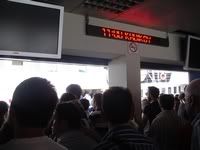
The trip across the mouth of the Bosphorus where it joins the Sea of Marmara took about 35 minutes. As the ferry pulled into the busy harbor, I could see the huge yellow orb of the giant grapefruit beckoning me to my right. Directly across from me on the other side of the harbor was an immense Teutonic structure that that seemed to be poised at the very edge of the water.

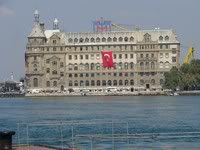
By the time the ferry drew within several feet of the pier, there was a sudden mad rush to leap upon the land, which I knew well at that point is a typical custom of the region. I stood off safely to the side for a while, figuring it would offer me the best chance to avoid getting trampled. As I waited a few moments for the anxious crowd to diminish, I noticed that another very large crowd had lined up to board the ferry, equally anxious to leave Kadıköy.
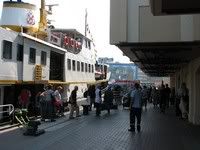

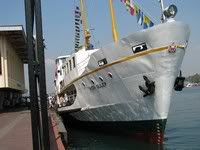
Soon, the entire pier was deserted and as I looked back at the quiet little terminal building, there was no clue to suggest the massive throng of people that had just passed within its walls just moments before.
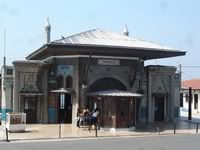
I decided that I would first explore the area by checking out the imposing brown structure situated on the other side of the harbor, figuring that any structure that boasted such an imposing edifice might actually be mission control for the giant grapefruit. In order to avoid walking along the heavily trafficked Tibbiye Caddesi, I clung as close to the edge of the water as I could. However, I soon found myself in an immense parking area in which at least one hundred large green or blue buses were weaving their way over the asphalt.
The moment that I escaped from this area, I waded into an even larger sea of vehicles comprised of nothing but dolmuşes as far as I could see. Indeed, a nearby sign advertised, "Kadıköy Dolmuş Duraklari," the "Kadıköy Dolmuş Station." There were white ones, blue ones, yellow ones, literally many hundreds of dolmuşes, most quietly parked and each bearing a small sign advertising their destination mounted on their windshield. They sat silently awaiting passengers that they could stuff inside and I admit to feeling a little like a dolma myself surrounded by so many of these vehicles.
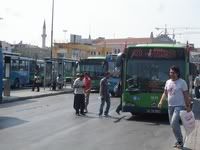

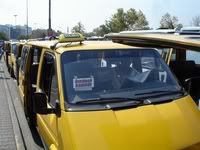
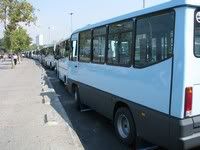
I eventually arrived at a hectic traffic circle where I was obliged to wander onto the busy street because dozens of hawkers had set up carts that monopolized the sidewalk. After making a sharp turn to the left I found myself on a street labeled "Haydarpaşa Gari," or "Haydarpaşa Terminal." To my left, a large mosque bearing a sign, "Haydarpaşa Protokol Camii" was tightly squeezed between the roadway and the water.
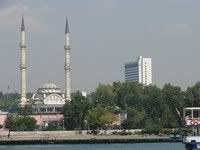
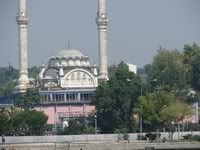
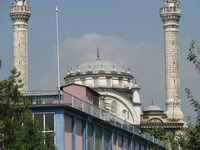
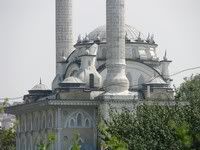
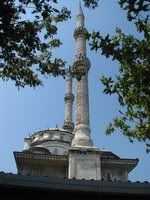
After another five minutes, I arrived alongside the ornate brown structure, which turned out to be the Haydarpaşa Train Station. Work on the current building had started in 1906 by two German architects who designed it based on the requirements of German investors who viewed it as an important link in a planned system connecting Berlin with Baghdad. The German empire had been plotting to seize control over east/west trade by bypassing the established trade route via the Suez Cancel. Today, it is the largest train station in Turkey.
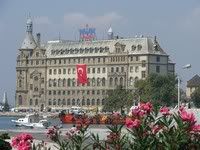

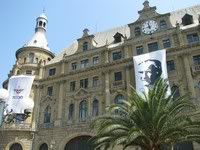
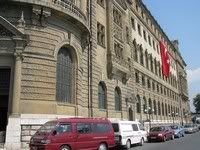
I undertook a leisurely stroll inside the building for a while, helped, in no small part, by the fact that crowds were fairly sparse. Exiting from the other end of the terminal, some snack stands were set up near the water and a handful of fishermen were wetting their lines. A few other tourists stood alongside an antique locomotive, admiring the view at the edge of the water.
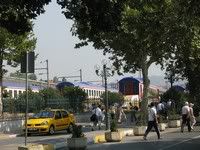

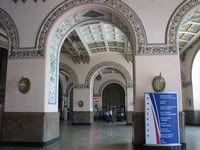
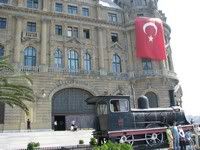
I glanced briefly south, back towards the ferry pier and soon sensed that something was missing. And then it dawned on me -- the giant grapefruit was no longer there!
 How could something so large just vanish into thin air? I looked to the left and to the right and could find no evidence of it anywhere. And then I looked up and found it flying high in the sky -- it had been launched!
How could something so large just vanish into thin air? I looked to the left and to the right and could find no evidence of it anywhere. And then I looked up and found it flying high in the sky -- it had been launched!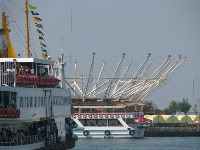

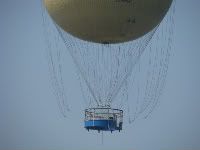
But as I looked more closely, I soon felt that something was terribly wrong. I noticed a large cylindrical capsule underneath the giant grapefruit but nobody appeared to be in it. Indeed, this development was so serious that the Turkish air force soon sent in a fleet of helicopters to attempt a rescue:

And the navy sent in ships to come to its aid. Even the Lord lent a helping hand:

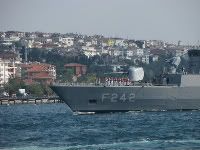
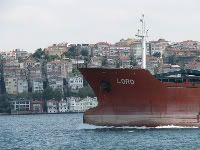

Catiköy
So much for my plans to prowl around the giant grapefruit today. As I began to walk back towards the ferry terminal, I was happy to see that it appeared that the giant grapefruit had been recovered and was being returned to its base:
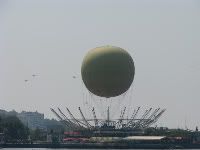
By the time I arrived back at the ferry pier, it was nearly time for me to start my journey back to the Hilton. Within the ferry terminal, I was bemused to discover a frequent ferry lounge but had no time to check it out.
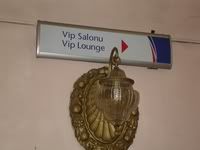
The ferry queue for Kabataş seemed to be even longer than the one for the outbound trip. During the journey back to the European shore, I chatted with some other passengers to see what I could learn about the abortive launch of the giant grapefruit. Evidently, the astronaut had been unable to complete his normal 22 hour sleep cycle and missed the flight. And as you can see from a recent publicity photo, a more appropriate designation would be "astrocat." Needless to say, this was quite a disappointing setback for all involved but the plan was to try again later in the day, after completing a suitable cat nap.
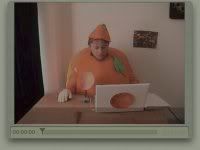



I was not altogether surprised to learn that the feline fellow's name was "Catiköy" and that the space port had, in fact, been named after him. I also learned that cats have been an important part of the Turkish space program almost from the very beginning because, for one thing, they find grapefruits to be much too tart to be palatable so would be very unlikely to eat their vehicle.
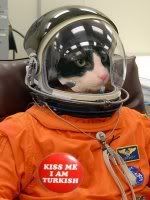
I now understood why I had seen so many cats wandering around Istanbul as if they owned the place and why anglers seemed to be more than willing to allow cats to steal their catch. Considering the very violent history of Turkey, many humans have been executed for much lesser crimes. I also learned a little about the mysterious Turkish Catman that I had encountered loitering around Sirkeci Station, who was evidently a retired cat herder.
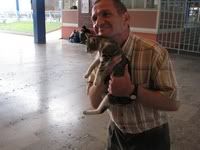
The pier at Kabataş appeared to be especially crowded by the time we docked. After riding the funicular back to Taksim Square and walking back to the Hilton, I had just about enough time for a quick shower and to check out so that I could catch the 2:30 PM Havaş bus back to the airport.
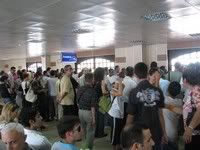
I opted to check out in the executive lounge because I wanted to glance at my email for a few minutes but all four computers were occupied by the usual cast of characters, all of whom were fully engaged in noisy video games.
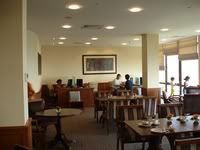
The Aqueduct of the Grey Falcon
As I exited the cool Hilton lobby and entered the sweaty Istanbul exterior, I was touched to see that a few Hilton staff members had gathered together in front of the hotel to wish me a bon voyage.
 I was also intrigued to notice a helicopter had been parked to my right, resting quietly on a small, grassy knoll. I still had more than enough time to walk to Taksim Square so there would be no need for me to avail myself of it.
I was also intrigued to notice a helicopter had been parked to my right, resting quietly on a small, grassy knoll. I still had more than enough time to walk to Taksim Square so there would be no need for me to avail myself of it.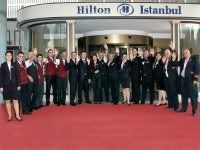

I arrived at the Havaş bus pickup location a little early so I escaped the heat of the sun by waiting under the convenient awning in front of the Turkish Airlines ticket office. Once the bus pulled up and I stowed my rollaboard in the luggage hold underneath, I soon found a seat and we were underway shortly afterwards.
Our routing from Taksim took us along Tarlabaşi Bulvari and over the Atatürk bridge, which I had walked across on my way to getting lost in the Fatih district during my explorations of the Golden Horn. On the other side of the bridge, we continued for a while on Atatürk Bulvari until the avenue passed under the Aqueduct of Valens, which had been a major component of the water distribution system at the time of the Byzantines.
This aqueduct was actually a single component of a much larger network of aqueducts and canals that ultimately spanned a total length of 250 km, the largest such system of its time. Water channeled through the aqueduct was eventually stored in three reservoirs and hundreds of underground cisterns, including the Basilica Cistern, where I had hidden from the Carpetbaggers during my first full day in Istanbul.
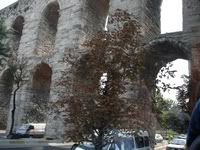
Also called the "Aqueduct of the grey falcon," the Aqueduct of Valens slices through Fatih district and terminates near the Fatih Mosque. Had I simply followed the path of the aqueduct instead of aimlessly wandering around the Çarşamba neighborhood, I probably would not have gotten lost in the Fatih district. Of course, then I might not have stumbled upon the huge outdoor market near the tomb of Selim the Grim. Sometimes a traveler can accidentally wander into the most interesting sites when he has no clue about his location or where he is going.
As originally conceived by the Emporer Valens, the path of the aqueduct was perfectly straight but after construction of the Fatih Mosque, it was bent out of shape. According to local legend, the stones used to build the aqueduct were derived from the walls of Chalcedon, to punish the "City of the Blind" because the emperor felt they were revolting.

After departing the bus at the arrivals level of Istanbul International Atatürk Airport, I spent a few minutes looking for access to the departures level. I am not sure whether or not there is a way to circumvent this but all airport visitors are required to submit to a security screening as soon as they walk in the door. From there, I took an escalator up one level and then located the Lufthansa check-in counter all the way to the left, not far from the Turkish Airlines counter.
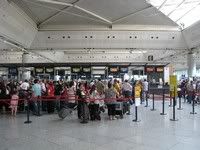
Most of the check-in lines were heavily populated with passengers but the business and Star Gold queues were fairly empty so the process was relatively quick and painless. The check-in agent initially presented me with an invitation to a contract lounge but I asked her whether I would be able to use the Turkish Airways CIP lounge instead. She responded, "if you wish," in a very lethargic and disinterested tone.
From the Lufthansa check-in counter, I walked past the Turkish Airlines check-in area, which seemed to be an endless sea of people and then sought out the left-most immigration section, which I had read on Flyertalk is often less crowded.

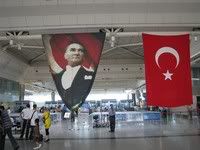
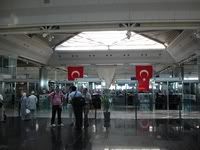
Going on a Gild Trip
Once I was airside, I quickly found a terminal directory and used it to locate the entrance to the Turkish Airways CIP lounge, which was situated all the way to my left. From what I understand, the designation "CIP" stands for "Commercially Important Person," a designation separate and distinct from "VIP", which is a title scrupulously reserved for government officials, who are the real very important persons in Turkey.
Although I doubted that I was very important commercially, I knew that I was entitled to avail myself of the CIP lounge due to my Star Gold status. However, I was somewhat curious what would happen if I just presented my Lufthansa business class boarding pass without presenting my Star Gold card. The lounge concierge did not appear to care at all and just waived me towards an entrance door on the left, after making some brief notations on a piece of paper.

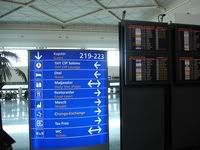
Once inside the lounge, I found the facilities available to be as diverse as in any lounge that I have ever visited. For example, in addition to an assortment of comfortable waiting areas, this lounge also included a children's playground, a library, a nursing room, a relaxation room and a prayer room. I briefly wondered whether I should make a brief visit to the latter facility in order to pray for my flight to be on time but I opted to explore the rest of the lounge instead. In hindsite, that might have been a mistake.

Several rooms in the expansive lounge were decorated in an ornate style featuring crystal chandeliers and cushy leather couches, all carefully gilded in imitation gold trim. I briefly wondered whether the ornate and gilded lounge décor had been acquired as a result of a spring cleaning or fire sale from Dolmabahçe Palace.
About eight or so free computers were available to guests but they were consigned to the older section of the lounge and worked about as well as any computer would function if it was hundreds of years old. I think I managed to locate the only functioning unit so I did not stay there very long because a fairly lengthy queue was rapidly forming nearby.
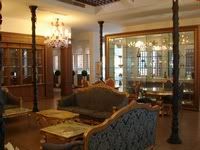
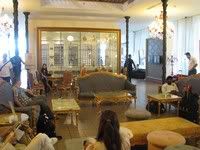
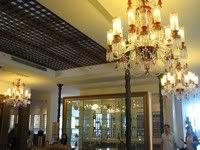
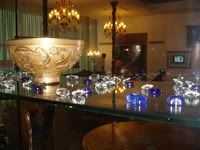
Other sections of the lounge boasted a more modern and airy decorative style, including the food area, the beverage section and the dining area. This section of the lounge was also equipped with very tall windows but they did not appear to afford passengers with any memorable views.
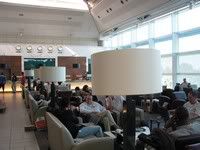

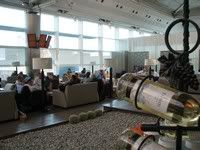

I found the food selection afforded by the buffet to be somewhat perplexing. At the far end of the modern section of the lounge, a long cafeteria-like buffet line had been set up in which passengers could avail themselves of salad, rolls, sandwiches, soup, cookies and some other assorted items. Unfortunately, the cafeteria paradigm extended all the way to the quality of the food, which I felt was some of the worst I had ever encountered in an airline lounge and as a (former) member of the UA Red Carpet Club for many years, I know from whence I speak.

The stale, shrink-wrapped sandwiches might very well have originated from the time of the Byzantines, based on their dryness and unpleasant texture. Two of the soda machines must have long ago ran out of syrup and dispensed only dirty water instead. The raw components of the buffet were decent enough but that was about it.
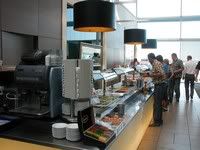
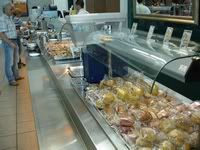
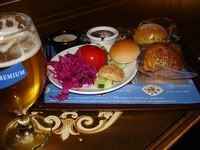
I departed the lounge at 5:00 PM, which I figured would be more than enough time to find the gate for my 5:50 PM flight to FRA. I walked past a pleasant looking food court that actually appeared to be relatively sedate and comfortable. From there I continued walking further through the terminal, which took me past another immigration checkpoint, whose endless queues made it seem like it was anything but sedate and comfortable.
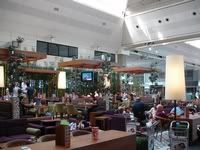

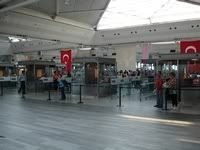
Playing the Game of Long Donkey
The entrance into the departure lounge was not yet open by the time I arrived at gate 204 because a delayed flight to Kiev was still parked at the jetway. We were finally permitted to submit to an additional security screening after waiting for about 20 minutes and I eventually settled into a front row seat for what I figured, incorrectly, would be a slightly delayed flight to FRA.
At first, the spacious waiting area seemed pleasant enough, the climate control system was almost working properly and Lufthansa had kindly deployed a very generous array of reading material available in an assortment of languages. As I looked towards the front of the room, I noticed a prominent sign advertising priority boarding so I had every confidence that Lufthansa had everything well under control. In hindsight, I probably should have instinctively recognized the inherent fallacy of my conclusion right away.
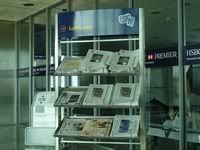
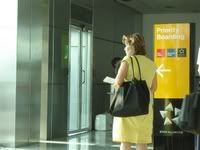
While the Kiev flight was still quietly parked at the gate, many passengers politely settled down amongst one of the many seats behind me. However, other passengers resolutely strode to the front of the room where they waited impatiently to board our plane, which had not even landed at that point.
After 20 minutes, the Kiev flight finally pulled away but our gate remained empty for another hour. During that time, the gate agents made frequent announcements in which they reminded passengers that our flight was delayed, the inbound plane had not yet arrived and when it did so, its passengers would need to deboard and the plane cleaned and prepped for our flight before we would be able to board. They patiently explained that there was no point in lining up near the jetway and that passengers would be much more comfortable seated in the waiting area.
From what I could see, these recurring missives really did have a very noticeable effect on the passengers. With each successive announcement, even more passengers would arise from their seats and join the crowd gathered in the front of the room. Perhaps the Turkish version of the announcement was actually encouraging passengers to line up as soon as possible so they would not miss their chance to be first to board? I only had the English version to go by so I cannot say for sure.


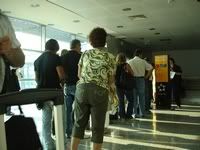
To say that the line assembled near the plane-less jetway continued to grow would be an understatement. The most misleading aspect of such an assertion would be the word "line" because there was, in fact, nothing linear about it. Consider the following series of photos that were taken over a 60 second period during a time at which there was still no plane at the gate. Continued entreaties from the gate agents did nothing other than to stir up the crowd even more and compel those who had been seated to rise up and join the fray.
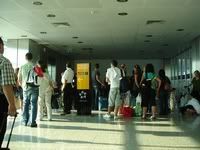

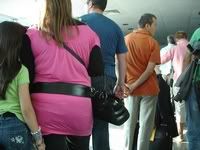
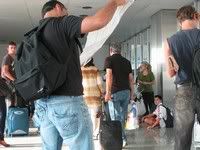
The line eventually grew so long that at first I thought that it might just be an impromptu version of the traditional Turkish game of Uzun Essek, Long Donkey.
 The game of Long Donkey requires two teams, dubbed "donkeys" and "jumpers." After the donkey team forms a very tight and compact line, the objective of the jumper team is to crash the line, which is usually accomplished by jumping on top of the other team. If nothing else, this popular game certainly embodied suitable training for the local populace to contend with a lifetime of Turkish queues. And in the particular scenario unfolding before me, what else could it be but a game of donkey in which unruly and compact lines were formed by people who were acting like "a
The game of Long Donkey requires two teams, dubbed "donkeys" and "jumpers." After the donkey team forms a very tight and compact line, the objective of the jumper team is to crash the line, which is usually accomplished by jumping on top of the other team. If nothing else, this popular game certainly embodied suitable training for the local populace to contend with a lifetime of Turkish queues. And in the particular scenario unfolding before me, what else could it be but a game of donkey in which unruly and compact lines were formed by people who were acting like "a
 es?"
es?"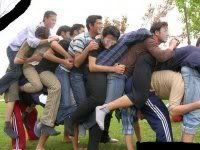
I have certainly witnessed more than my fair share of "gate lice" flocks in my domestic US travels but this particular infestation was more like a gate swarm than anything else. Later on, when one of the gate agents happened to be walking in my direction, I asked her whether Lufthansa was still planning to process priority boarding for business and Star Gold passengers. She assured me that they did, although, as it turns out, they did not.
The March of the Gate Sultan
Shortly after the Lufthansa plane finally pulled up to the jetway, a man arose from the back of the room and plunged right into the chaotic throng, with nary a pause nor a "afedersiniz." With his entire family in tow, he simply sliced into the crowd, stubbornly pushing anyone aside who had the misfortune to be in his way. Having efficiently conquered the crowd of passengers, he planted his baggage immediately in front of the jetway, like a proud flag of battle. There he remained for the next 40 minutes, on occasion furtively glancing around the room on guard for possible invaders or usurpers.
From the vantage point of my front row seat, I eventually noticed a sign of activity near the gate. As I discerned some slow movement of wheelchairs along the jetway, there was a sudden surge amongst the passengers as the crowd appeared to rush the gate. I wandered over for a closer look and made eye contact with the gate agent, who was clearly fighting a losing battle with the crowd. With still no attempt to utilize the public address system, I could hear her futilely plead with the crowd to permit business class passengers to board.
I eventually made it on board to find a business class cabin that had been long ago settled by the gate sultan and the rest of his empire. Their royal heinies filled most of the seats and their luggage monopolized most of the overhead bins. I settled into seat 3F, where I sat for a while watching steam pouring out of air conditioning vents that were struggling mightily to contend with the oppressive humidity that had accompanied the passengers onto the plane.
Just as the flight attendants were about to close the door, a sullen looking female passenger boarded the fully packed aircraft and made a bee line right for my row. Rather than settle into the available aisle seat, she aimed right for the middle seat and struggled to disengage the tray that had been semi-permanently deployed there. Given that this is the single object that actually differentiates a business seat from an economy seat, I politely pointed out that she would be much more comfortable in the aisle seat. Once the doors were closed and armed, we finally pulled back from the jetway and began a short meander around the tarmac.
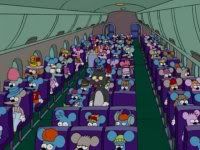
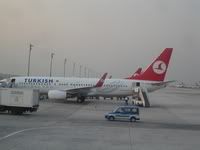
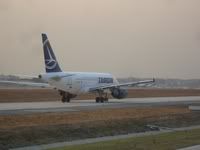
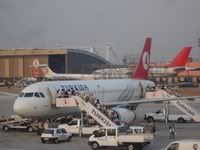
As we gained altitude, I looked out over the rapidly receding land and water to see an expansive view of hundreds of ships scattered across the calm surface of the Sea of Marmara. Despite the fact that there was well over an hour of sunlight left at that time of year, the sky had taken on a very peculiar orange glow. The atmosphere was infused with an odd eerie haze, almost is if the sun was partially obstructed. I had never seen anything quite like it before so I tried to squint as best as I could to get a better view.
You can imagine my surprise and delight when I noticed three large yellow spheres passing very close by the fuzzy orb of the sun. There could be no other explanation other than that A.D.A.L.A.R., the Turkish space program, had successfully launched not one or two, but three giant grapefruits from their secret headquarters in the harbor in the Anatolian tip of Istanbul. My heartfelt congratulations to Catiköy and the rest of his team at citrus control!
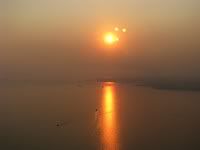
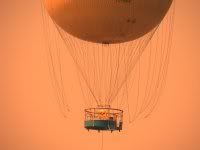
After takeoff, we continued to climb through the hazy sky as the flight attendants offered a drink service. I ordered a Hefeweizen but was quite surprised when it was deployed in a very large and heavy glass bottle, not at all expected at such a time of weight restriction and high fuel cost. Thirty minutes later, a meal was delivered which was sort of almost decent although the eggplant was a tad too raw for my tastes. I also asked the flight attendant for a pillow, which she never brought.
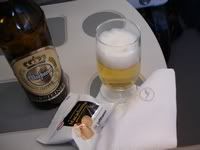
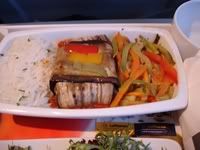
We landed at FRA well over an hour late after which we needed to be bussed to the terminal. Under the same scenario with UA on my outbound flight, this was not an especially terrible experience. Perhaps due to the late evening hour, the immigration queue was an absolute disorganized zoo that took me a good 50 minutes to pass through. From there, I hiked to the train station, purchased a one way ticket to Frankfurt Central station and finally checked into the Le Méridien Parkhotel at 10:00 at night.
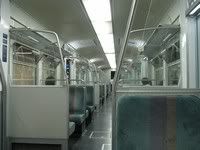

United Coffee Break
I checked out of the Le Méridien Parkhotel at about 8:00 AM, having enjoyed my free night there, which I felt was worth every penny. I had been planning to grab breakfast at the airport lounge but, just as I was about to exit the lobby, I noticed that the hotel had set up a small table with some cups, saucers, an urn of coffee, an urn of "tee" and a half dozen croissants. I thought that was certainly a very nice gesture from a hotel that had instantly responded "nein" when I asked whether they offered a complimentary breakfast to platinum guests during check-in the prior evening. Then, upon closer inspection, I noticed that there was a sign on the table that said, "Coffee Break, Only for United Crew Members."
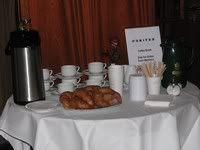
I journeyed back to the train station via the underground passageway that I had discovered during my Frankfurt trek the preceding week but when I emerged in the station, I initially was unable to locate the ticket office because I was on the lower level. Once back on the main level, I attempted to purchase a ticket from an agent but was met with surprising resistance. She initially refused to take my credit card, explaining that it costs the railroad a lot extra in processing fees. I explained that I had only one Euro left and did not feel it justified to use an ATM to get more. I also added that the agent at the airport had seemed to be quite willing to complete this very same transaction the prior evening.

Once back at the airport, I located the UA check-in counter, which was entirely devoid of passengers. I proceeded to check-in for my flight and was obliged to re-request that my seating assignment to 15A be restored, since I had been unceremoniously unassigned from it several weeks prior by the UA random seat reassignment demons. I then asked her about upgrading from business to first but she said that I would only be allowed to do so for cash. She correctly pointed out that neither a UA systemwide upgrade nor my unused LH paper systemwide upgrade would be permitted.
From the check-in counter, I wandered over to the extremely lengthy security queue, which took a good half hour for me to complete. My carryon was selected for greater scrutiny, which ultimately turned out to be triggered by my pfeffer mill, which I have previously carried with me through security on many occasions. I had a nice chat with the security staff for a while until another passenger yelled at us that he was in a hurry.
The Senator lounge was packed to the gills by the time I arrived but I was eventually able to secure a spot near a computer after circling around the area for about 20 minutes. Once comfortably settled in, I foraged for food and then wandered over to the pasta bar, where I enjoyed several helpings of pasta and pesto cooked to order by Brandau:
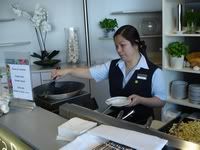
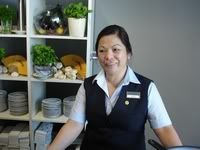
I spent the next two hours sitting by the computer, enjoying a diverse assortment of munchies and catching up on FT. During that time, several passengers approached me regarding access to a computer and I probably could have made out very well had I started an auction to sublet my space.
Given that UA, in its slippery slope to cheapness had now decided that butter is much too expensive to serve in international business class or domestic first, I prepared a small care package of butter that I could deploy later on during my flight. Some of my previous gestures have included a garbage bag full of pretzels that I once distributed to the entire coach cabin on a flight from SFO to PDX. I also added a few bits of candy to gift to the flight attendants.

By the time I was ready to leave, I looked over my tall stack of dirty dishes and realized that I had a satisfying meal indeed. Within seconds of vacating my seat to leave the lounge, another passenger who had been patiently hovering for the past two hours descended upon it.
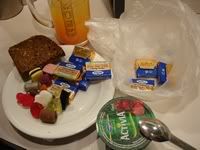
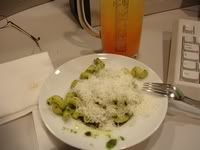
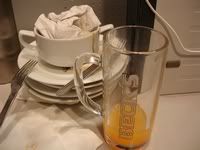
Why Are You Taking Pictures of the Food?

As soon as I arrived at the UA gate, I asked the agents whether I could upgrade to first from my Z fare and one minute later it was a done deal. I suppose that had I tried to accomplish this upgrade somewhat earlier in the day, I would have been able to avail myself of the first class lounge but I had been perfectly satisfied in the Senator lounge, which had kept me well fed, well entertained and well lubricated during my visit.
Once aboard the plane, I wound up occupying one out of five assigned seats in the first class cabin; the remaining five seats remained empty. As a first time first class visitor to UA's newly configured 747, I felt that it was a little nicer than business class but not profoundly so. The entertainment system was the same as business class and worked just as well, which is to say, sometimes not at all. But when it did work, it was a thing of beauty.
Unlike business class, the leg area of the seat was somewhat wider and first class afforded passengers with some very small bins that could be used to store items such as eyeglasses and papers, features that were conspicuously absent from the new business class seat. Located immediately across from me in the center of the aisle was a somewhat roomier storage cabinet that was large enough to comfortably accommodate my carryons.
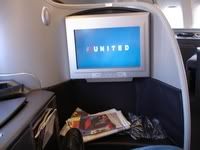
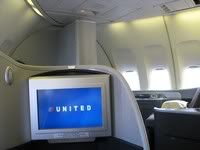
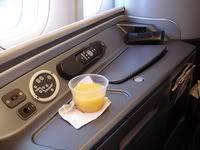

Given that I was probably the last passenger to board, I did not have to wait very long for the doors to be closed and armed and for the plane to commence its taxi. In less than 20 minutes, we had taken off and passed over downtown Frankfurt, which I stared at for a while in an effort to retrace my footsteps during my daytrip one week prior.
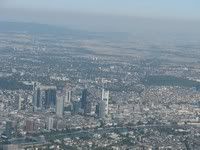
I then turned my attention to the entertainment system but was soon interrupted by the first of several beverage services delivered by the very friendly and attentive flight attendant.
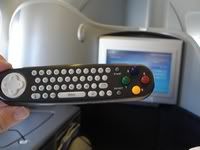
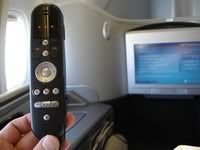
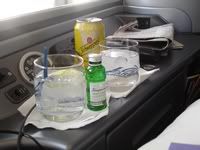
Within a half hour, meal service started, which began with an appetizer, and then continued with a serving of soup, followed by salad. In order to visit the rest room, I was able to get out of my seat fairly easily by placing some meal items on the surface of the side console and re-stowing my tray.
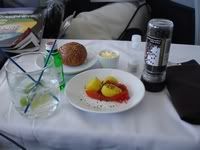


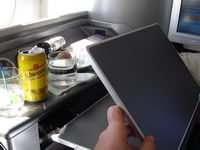
The main course was followed by an ice cream sundae and coffee. UA currently considers ice cream (or at least the dry ice required to store it) much too expensive to serve in transatlantic business class these days and no longer serves it, along with real butter. To me, this is still someone shocking (and foolish) for seats that typically sell for many thousands of dollars. In any case, the flight attendant later strolled by and amicably wondered out loud why I was taking pictures of all of the food.


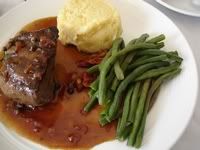
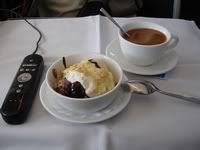
About an hour before our arrival at IAD, a small snack was served and we then landed on time, if not a few minutes early. However, there was no attempt to deboard the plane by cabin so by the time I arrived in the midfield customs and immigration facility, the room was already packed with people.
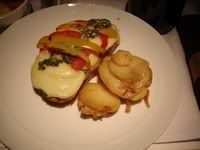
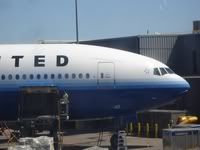
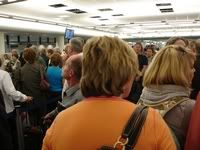
The Lounge Racket
Once the immigration formality was finished, I was able to seek refuge in the international first class lounge, not a great lounge by any imagination but still far superior to alternative accommodations at IAD. The concierge seemed duly satisfied with the boarding pass stub from my just completed flight from FRA so I sought out a seat in the spacious and nearly empty lounge where I hung out for the next two hours.
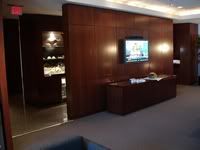

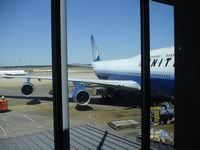
Another advantage of this lounge over the Red Carpet Club is that there is a decent selection of munchies, which included roasted vegetables, sandwiches, smoked salmon and sushi. There was also unlimited self serve alcohol available, which I skipped.



Despite the paucity of passengers, a television located at the far end of the lounge was cackling away at a fairly high volume, which seems, sadly, to be UA's standard operating procedure. A short while later, another passenger entered the lounge, marched straight towards the incessantly cacophonous racket and immediately unplugged the television so a thumbs up to him. ^
I departed the first class lounge at 5:30 PM for my 6:16 flight back to PDX, whose gate was a bit of a schlep away. Expecting the dense and chaotic mobs of passengers that typically swarm through the very narrow and uncomfortable concourse at IAD during UA's evening bank of flights, I was somewhat surprised to discover that the terminal was not as densely packed as usual. Once I boarded the cabin of the A320, only half of the 12 first class seats were occupied, not counting the woman who tried on several different occasions to self-upgrade her children from economy to the empty first class seats.
The Lazy Flight Home
Perhaps the profound paucity of passengers was due to a low-traffic travel day (labor day eve), the crumbling US economy or UA's profound and astounding diminution of service that typifies flights in the premium cabin these days. More likely, it was some combination thereof.
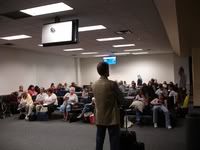
Regarding the reduction of service, UA's cutbacks were clearly evident on this flight, especially with respect to the meal that was served in its entirety with all courses on a single tray, including the small blob of chocolate cake that now substitutes for ice cream on this transcontinental flight. Sadly, the crew serving the first class cabin also chose to add very little value of their own, evidently opting to ensure that all service standards would be lowered to the same dismal theme and precedent set by corporate headquarters in Chicago.
After providing "service" for the first half hour or so, one flight attendant decided to rest in one of the empty first class seats where he slept for the remainder of the flight. The other one unceremoniously dumped tray linens on the backs of the seats about 15 minutes after takeoff, clearly figuring that if she did not accelerate meal service on this six hour flight, she might run out of time.
 Any detritus that had accumulated during the flight was never picked up and my seat mate ultimately became so disgusted that he discarded some of it in full view on the headrest of the seat in front of him. It was never picked up from there either.
Any detritus that had accumulated during the flight was never picked up and my seat mate ultimately became so disgusted that he discarded some of it in full view on the headrest of the seat in front of him. It was never picked up from there either. 
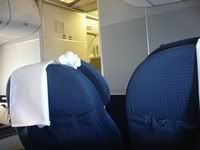

The only discernable sign of life and attention from the lazy and disinterested flight attendants occurred when I asked the one who wasn't sleeping whether she knew where I could obtain my very own "Glenn Must Go" bracelet. She even volunteered to ask the pilot whether he had a spare bracelet. However, she could not actually be bothered to get back to me and let me know about the outcome of my request.
That being said, my primary objective that evening was just to return home from a very long trip so despite any unmet first class service expectations, my actual service needs were really very minimal. In the grand scheme of things, I suppose that none of this was terribly important.
As we began our initial descent towards the Portland area, we meandered along the path of the Columbia River Gorge as it slices its way through the High Cascades. We soon passed alongside several of the area's resident volcanoes, all sporting tall glacier encrusted peaks even during the late summer season. I could easily see Mount Adams, fairly close by, just to the north of the river. Mount Rainier was visible far in the distance and Mount St Helens was situated just slightly to the northwest.


Having flown nearly 26,000 miles in the past week, I was profoundly exhausted by the time we landed at PDX and I was very glad to be back at home where I hoped to get a bit of rest before planning my next journey. I had only spent a week in Istanbul on this trip so someday I would like to return to Türkiye, a land of sultans and pirates, mosques and palaces, castles and yalis, bazaars and carpetbaggers and, perhaps most impressive of all, giant flying grapefruits.
Last edited by LarryU; Nov 30, 2008 at 12:21 am
#35
Join Date: Jan 2005
Programs: LH FTL, BA Silver
Posts: 126
Thanks a lot for this amazing trip report.This will be my guideline for a trip to istanbul.
Did the FA sell you the warsteiner(picture on the flight from IST-FRA) as a hefeweizen?i hope not.It is not even a pilsener, but just a profound example how marketing can make tasteless crap into gold.
I really like the pictures.what cameras are you using?
cheers
Did the FA sell you the warsteiner(picture on the flight from IST-FRA) as a hefeweizen?i hope not.It is not even a pilsener, but just a profound example how marketing can make tasteless crap into gold.
I really like the pictures.what cameras are you using?
cheers
#36
Original Poster
Join Date: Feb 2000
Location: Lake Oswego, OR
Programs: UA 1K 2MM, Marriott Lifetime Platinum, Hilton Diamond
Posts: 3,202
Thanks a lot for this amazing trip report.This will be my guideline for a trip to istanbul.
Did the FA sell you the warsteiner(picture on the flight from IST-FRA) as a hefeweizen?i hope not.It is not even a pilsener, but just a profound example how marketing can make tasteless crap into gold.
I really like the pictures.what cameras are you using?
cheers
Did the FA sell you the warsteiner(picture on the flight from IST-FRA) as a hefeweizen?i hope not.It is not even a pilsener, but just a profound example how marketing can make tasteless crap into gold.
I really like the pictures.what cameras are you using?
cheers

Regarding the photography, I traveled with two cameras, a small 3X Sony that I carried around in my pocket at all times and a much larger Canon S5 that was not very pocket friendly. I had just purchased the Canon because of its 12X optical zoom and I found the image stabilization did a fairly admirable job of maintaining focus at even the highest magnifications.
I had been especially interested in the 12X zoom because some of my more recent forays into Borneo and Bali with my older camera resulted in much closer contact with the indigenous wildlife than I would have preferred.

Last edited by LarryU; Dec 3, 2008 at 11:47 pm
#38
Join Date: Feb 2009
Location: MSP
Programs: DL SkyMiles, UA Mileage Plus
Posts: 319
LMAO.... that really gave me a good laugh....
Thanks for sharing your experience. I'm going to spend 3 weeks in Turkey this upcoming end of march thru mid april..... very informative.....
#39
Join Date: Dec 2007
Location: Body in Downtown YYZ, heart and mind elsewhere
Programs: UA 50K, refugee from AC E50K, Marriott Lifetime Plat
Posts: 5,132
I know this is from October 2008, but I still think this is one of the best-written TRs out there.
Thanks LarryU! ^
Thanks LarryU! ^
#40
Join Date: Oct 2007
Location: NY Metro
Programs: UA Silver, BA Silver, Hyatt Plat, Hilton Gold
Posts: 408
thanks for such a great TR write up, Larry!
i have to add that all of my departures from IST have been the same experience, where a flood of pax completely inundates the GAs. all of my travel to and from IST has been on EK, so this problem is not airline specific. i have to wonder, if it's a cultural thing where the pax (noticeably are mostly of Turkish origin) crowds the gate and have no regard for boarding priority.
i remember once my colleague and i had to fight through the crowd just so that we could board with our J tickets. surprisingly the crowd was not upset as we pushed our way through.
i have to add that all of my departures from IST have been the same experience, where a flood of pax completely inundates the GAs. all of my travel to and from IST has been on EK, so this problem is not airline specific. i have to wonder, if it's a cultural thing where the pax (noticeably are mostly of Turkish origin) crowds the gate and have no regard for boarding priority.
i remember once my colleague and i had to fight through the crowd just so that we could board with our J tickets. surprisingly the crowd was not upset as we pushed our way through.
#42
Join Date: Jan 2006
Location: SFO
Programs: UA MMGold, HH Diamond, Marriott Plat
Posts: 1,263
I visited Istanbul in January. Came across the menu of Yoros Cafe and happy to report the squirat is no longer available on their menu now

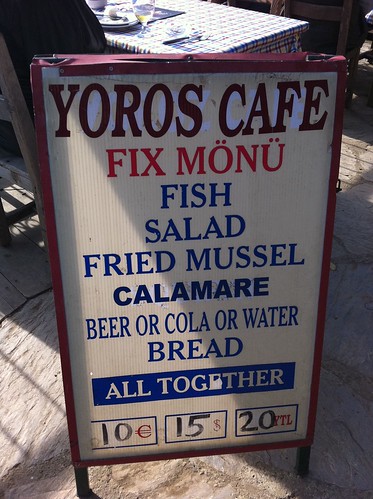
Last edited by wendySFO; Feb 11, 2011 at 3:28 pm




















